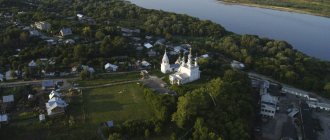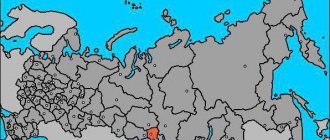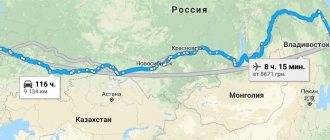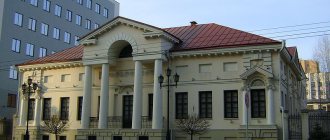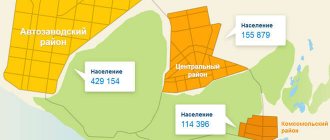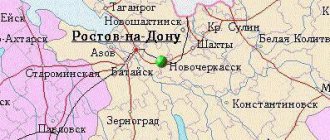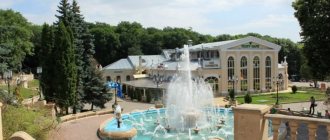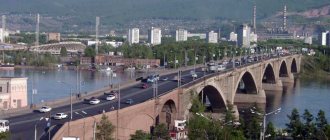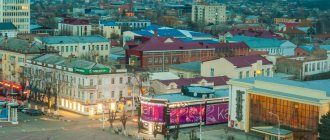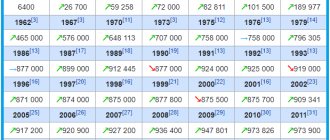The city of Tyumen is the administrative center of the Russian Federation. It, that is, the city, is located in the Tyumen region and has the status of an urban district, since it is the only populated area in the district.
The peculiarity of Tyumen is that it is the first Russian city located in Siberia. Its history goes back to the distant past, starting in 1586.
The origin of the name of the city has an interesting history: there are many legends in Siberia, one of which is about the word “tumen” - “ten thousandth army”. In Bashkir folklore, the story about “tumende” - below is entrenched.
Another story says that the name of the city comes from “chemgen,” which literally translates as “city on the way.” There is also an alternative version - the word “Tyumen” appeared as a result of the merger of two Turkic words “tyu” and “myana”, which means “my property”.
To be fair, it must be said that there are other versions of the origin of this name. These are the most popular among them.
Lev Gumilyov also put forward his own version of the name of the city, correlating the word with the number of families (10 thousand) received under the control of the eldest son of the first Xiongnu ruler (another equally interesting legend).
Where is Tyumen located on the map? How to find her?
The Russian Federation is one of the largest, and therefore it can be quite difficult to find a specific area. To find Tyumen on a map of Russia, you should use Google map: it will help you determine the area and the city itself. This is one of the easiest ways.
Tyumen is located in Siberia, in the Urals. It is separated from Moscow, the capital and cultural center of the country, by almost 1,800 km. The nearest regional centers are Yekaterinburg and Chelyabinsk. From the East, Tyumen borders on a state reserve - Siberian forests, which stretch across the center of the country for tens of hectares.
If we take all of Russia as a whole, then Tyumen is located in the South-West. From the South-East it borders with Kazakhstan and Omsk.
Symbolism
The modern coat of arms and flag of the Tyumen region were approved on October 24, 2008 by the Tyumen Regional Duma. In the center of the coat of arms is a tricolor shield, on which there are three azure crowns with patterns characteristic of the indigenous peoples of the North, and a golden disk divided into two parts. The upper semicircle of the disk has the appearance of a shining sun, and the lower one is an azure disk with seven black pillars, symbolizing oil and gas reserves in the region. The shield is topped with a gold imperial crown. To the left and right there are shield holders - black sables, whose muzzle, throat and chest are painted gold. At the bottom of the coat of arms, on two golden arrows, there is the motto: “Siberia will grow.”
The flag consists of three horizontal stripes of different colors: white, blue and green. The shaft has a red triangle, the top of which is directed towards the center. On the blue stripe there are three crowns with the same patterns of the northern peoples.
A little about Siberia
Western Siberia is one of the most impassable and wild places in the Russian Federation. Cities and urban-type settlements here are located at a great distance from each other. In contrast to Moscow and St. Petersburg, a quieter and more natural atmosphere reigns here.
It is true that the world-famous Siberian fires have now spread. The smog that covered the forests stretched for hundreds of kilometers. The solution to this problem remains a mystery, since it is physically impossible to extinguish such an amount of forest without special technologies.
Siberia is known for its harsh conditions, especially in winter. However, now the Siberian winter is many times warmer, which is associated with global warming and rising temperatures throughout the country. Some residents of Siberia even complain about the incredible heat during the cold seasons.
In general, the climate is temperate continental. Showers are possible in summer, but winter is windless and dry, due to which the low temperature is not felt so much. The disadvantages include a sharp change in weather: wild cold can turn into warm weather after a day.
If you believe the general indicators, the temperature in January does not exceed -15-25 degrees Celsius. However, the very minimum was recorded in 1958 – at that time the temperature reached -49.8 degrees Celsius.
Previously, the average summer temperature was +19, and the maximum reached +37, but now it has become much warmer in Siberia, despite the fact that there is no official data on the current temperature regime in warm seasons (or is rather vague).
It can be assumed that in 10 years the temperature will be more than warm. But Siberian air will remain clean, compared to the impurities that residents of large cities and suburbs are forced to breathe (especially when it comes to Moscow and St. Petersburg).
Data by year
The population of Tyumen can be considered for twenty years by year, starting from 1990 (all figures are indicated in thousands of people):
- 1990 - 486.0.
- 1991 - the population increased this year and amounted to 494.0.
- 1992 - increased by 2 thousand people and amounted to 496.0.
- 1993 - decreased and amounted to 493.0.
- 1994 - 491.0.
- 1995 — 492,0.
- 1996 - 495.0.
- 1997 - 499.0.
- 1998 - 500.0.
- 1999 - 503.8.
- 2000 - 503.4.
- 2001 - 500.2.
- 2002 - increased by 10 thousand people and amounted to 510.72.
- 2003 - 510.7.
- 2004 - 510.3.
- 2005 - here you can see an increase of 28 thousand people, this year it was 538.3.
- 2006 - 542.5.
- 2007 - 549.9.
- 2008 - 560.0.
- 2009 - 570.35.
- 2010 - 581.9.
- 2011 - 581.8.
- 2012 - starting from this year, population growth becomes stable and this year it amounted to 609.7.
- 2013 - 634.2.
- 2014 — 679,9.
- 2015 - 697.04.
- 2016 - 720.6.
- 2017 - 744.6.
- 2018 — 768,4.
- 2019 - 788.7.
- 2020 - 807.3.
You can see that over these twenty years the number has almost doubled. The increase occurred due to the arrival of people from other countries, a high birth rate, and an improvement in people's lives.
Enterprises and industry
Tyumen is the “oil and gas capital of Russia”!
On the industrial side, the city is well developed with:
- oil products production;
- production of machinery and equipment;
- creation of electrical, electronic and optical equipment.
The hotel and restaurant business has also become widespread in Tyumen: at the moment there are about a hundred popular hotels operating on the territory, not counting private entrepreneurs who rent out apartments and rooms for daily rent. Such rapid development of hotels is associated with business tourism.
The fact is that scientists, businessmen and other people interested in the development of the oil and gas industry and the production of petroleum products, as well as research activities in these areas, often come to Tyumen.
Students who plan to find themselves in industry or industries related to it also flock here. There are prospects for development, and great ones at that, especially for those who love industrial enterprises and the hotel and restaurant business.
It should be noted that Tyumen has one of the lowest unemployment rates in Russia, and this is an indicator! Demographics are developed (mostly associated with students).
Minerals
The Tyumen region has hydrocarbon reserves that are noticeable on a global scale. It is in its depths that the bulk of the country's gas and oil is concentrated. The total volume of geological exploration drilling exceeded 45 million m3. Oil is produced mainly in the Ob region, and gas in the northern regions. The process is associated with the rapid development of the region. The most famous and richest hydrocarbon deposits are Fedorovskoye, Mamontovskoye, Priobskoye, Samotlorskoye, and gas fields - Yamburgskoye, Urengoyskoye, Medvezhye. Peat, quartz sand, sapropels, limestone, precious stones, and metal ore (copper, chromite, lead) are mined.
Transport hubs
In Tyumen, only ground transport operates: numerous buses and taxis run from the bus station. Tyumen trolleybuses deserve attention - the largest network of closed trolleybuses in the Russian Federation. According to official data, Tyumen is the largest regional unit where electric transport does not operate (in particular, trams and metro).
There are 2 airports here – Plekhanovo and Roshchino. Particular attention is paid to the latter, since Roshchino has international status.
Despite the fact that Tyumen is located far from the center of Russia and forms part of wild Siberia, it is well developed and does not lag behind the rest of the regional centers of the Russian Federation in development, with the exception of two.
A special part is science: the oil and gas industry in the city gave impetus to the founding of numerous universities and research institutes. Here, almost every specialist can find application for their potential in the industrial sector.
Like any regional center, Tyumen has its own cultural monuments, churches, theaters, cinemas and parks. Among the attractions are the “Lovers' Bridge” and the embankment of the Tura River.
Population of the Tyumen region
Having learned about the area of the Tyumen region in the ranking of regions, how large it is, we can draw a logical conclusion that the population should be large. However, allowance should be made for the harsh climatic conditions in which it is very difficult to live. The Tyumen region with a population of 3,615,485 people (according to 2016 data, including autonomous okrugs) does not even make it into the top twenty of the ranking of Russian regions according to the results of the latest census. And this despite the fact that it is the third in area. The population density is very low - 2.47 people per square kilometer. Most people live in cities - 80.12%, which is quite logical, since in conditions of permafrost and tundra it is difficult to survive in remote villages and towns.
As for the national composition, the majority of the population, according to the 2010 census, are Russians (69.26%). In second and third place in terms of numbers are Tatars (7.07%) and Ukrainians (4.63%). There are even fewer Bashkirs and Azerbaijanis, 1.37% and 1.28%, respectively. The share of other peoples is less than 1%. The indigenous inhabitants of the north: Nenets, Khanty and Mansi are represented by 0.93%, 0.86% and 0.34%, respectively.
How to get to Tyumen?
You can get there in several ways, depending on your finances and comfort:
- arrive by plane;
- by buses from Yekaterinburg, Omsk and other administrative centers;
- on minibuses (we are talking about the suburbs).
Of course, the plane is the fastest option. Two hours - and you are on the other side of the country! A ticket to Tyumen will cost up to 7,000 thousand rubles. The railway method is more budget-friendly: it takes longer, but is much cheaper. Buses run from the bus station to the city.
You can take advantage of private car/minibus transportation that will take you directly to the center.
As many car drivers notice, there is a convenient transport interchange, which allows you to:
- get to the city center from any corner in a few minutes;
- cross without any problems.
If you are outside the country, it is best to choose a plane. You can get to Tyumen by rail from Kazakhstan without any hassle. If we are talking about Krasnoyarsk, Nalchik, Moscow or St. Petersburg, then a plane ticket is your main assistant!
Attention! Due to fires and thick smog, traffic may be limited!
Despite the fact that the environment has suffered significantly, outside of Tyumen you can have a good time fishing or simply relaxing in the Siberian depths. But solely at your discretion and depending on the time of year.
As local residents note, it is better to fish in the cold seasons - in the summer you can’t have much rest, especially during fires.
Industrial parks
To accommodate new production facilities, four industrial parks operate in the region: “Borovsky” for small and medium-sized processing industries, “Bogandinsky” for large manufacturing enterprises, the industrial and logistics park “DSK-500” and the agro-industrial park “Ishimsky”.
“Borovsky”, with a total area of 27.9 hectares, was 93% full in August 2022: it housed 11 of their 12 possible residents. The largest park in the region, Bogandinsky, is located on 267.9 hectares and currently has four residents. In August 2022, the Russian government included these two parks in the federal list of projects for the creation of industrial parks, which will allow the region to reimburse the costs of creating park infrastructure from the federal budget.
Settlement history
The first inhabitants of the Tyumen region appeared 40 thousand years ago, as evidenced by data from archaeological excavations. The first population of the Tyumen region was nomadic. Sedentary residents appeared quite late; in the 13th-16th centuries, the Tyumen Khanate, consisting of Tatars and Kereits, was located here. In the 16th century, the Russian authorities began to build the Tyumen fort here, and later the city of Tobolsk arose in its place. In the 18th century it became the capital of the huge Siberian province. Often the lands of the province were shaken by various riots, but local authorities successfully dealt with them.
After the revolution, the troops of General A. Kolchak were stationed here, and only in 1919 was Soviet power finally established here, and Tyumen became the capital of the region. Since 1944, the region has existed within its current borders.

